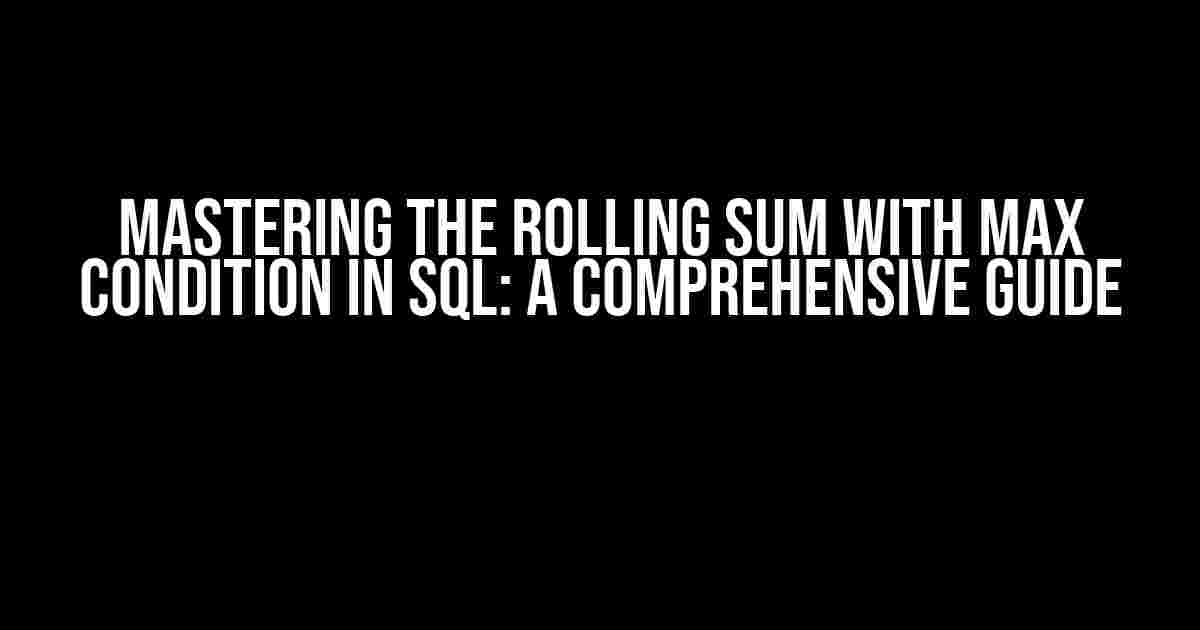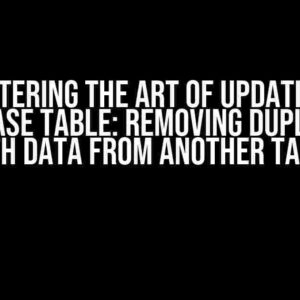Are you tired of struggling with complex SQL queries that involve rolling sums and maximum values? Do you want to take your SQL skills to the next level and become a master of data analysis? Look no further! In this article, we’ll delve into the world of rolling sums with max conditions in SQL and provide you with a step-by-step guide on how to conquer this powerful technique.
What is a Rolling Sum with Max Condition in SQL?
A rolling sum with max condition in SQL is a type of query that calculates the cumulative sum of a column while applying a maximum value constraint. In other words, it’s a running total that resets whenever the maximum value is exceeded. This technique is essential in data analysis, finance, and other fields where you need to track cumulative values with boundaries.
Why Do You Need Rolling Sums with Max Condition in SQL?
- Data Analysis: Rolling sums with max conditions help you identify trends, patterns, and anomalies in your data, enabling you to make informed decisions.
- Fraud Detection: This technique is useful in detecting fraudulent activities, such as excessive transactions or unusual spending habits.
- Resource Allocation: By tracking cumulative values with maximum limits, you can optimize resource allocation, ensuring that you don’t exceed budgetary constraints.
SQL Syntax for Rolling Sum with Max Condition
WITH rolling_sum AS (
SELECT
id,
value,
SUM(value) OVER (PARTITION BY id ORDER BY date) AS running_total,
MAX(value) OVER (PARTITION BY id) AS max_value
FROM
your_table
)
SELECT
id,
value,
CASE
WHEN running_total <= max_value THEN running_total
ELSE 0
END AS rolling_sum_with_max
FROM
rolling_sum;
This SQL query uses a common table expression (CTE) to calculate the rolling sum and maximum value for each group (id). The outer query then applies the max condition to the rolling sum using a CASE statement.
Breaking Down the Query
Let’s dissect the query to understand each component:
- CTE: The WITH clause defines a temporary result set (rolling_sum) that’s used to calculate the rolling sum and maximum value.
- Partition By: The PARTITION BY clause divides the data into groups based on the id column.
- ORDER BY: The ORDER BY clause specifies the order in which the rows are processed within each group.
- Running Total: The SUM(value) OVER (…) clause calculates the cumulative sum of the value column.
- Max Value: The MAX(value) OVER (…) clause calculates the maximum value for each group.
- CASE Statement: The outer query uses a CASE statement to apply the max condition to the rolling sum. When the running total exceeds the maximum value, it resets to 0.
Examples and Use Cases
Let’s explore some practical examples and use cases for rolling sums with max conditions in SQL:
| Example | Description |
|---|---|
| Transaction Tracking | Calculate the cumulative sum of transactions for each customer, resetting the sum whenever the total exceeds $1000. |
| Resource Allocation | Track the cumulative usage of a resource (e.g., memory) for each process, limiting the total to a maximum value (e.g., 100MB). |
| Fraud Detection | Identify unusual spending patterns by calculating the rolling sum of transactions for each cardholder, resetting the sum whenever the total exceeds a certain threshold (e.g., $5000). |
Common Challenges and Solutions
When working with rolling sums and max conditions in SQL, you may encounter some common challenges:
- Performance Issues: Use indexing on the columns used in the PARTITION BY and ORDER BY clauses to improve performance.
- Data Type Mismatch: Ensure that the data types of the columns used in the SUM and MAX aggregations match to avoid errors.
- Resetting the Sum: Use a clever reset mechanism, such as the CASE statement, to reset the rolling sum when the maximum value is exceeded.
Best Practices and Optimization Techniques
To optimize your rolling sum with max condition queries, follow these best practices:
- Use Efficient Data Structures: Choose the right data type and structure for your columns to enable efficient aggregations.
- Indexing: Create indexes on the columns used in the PARTITION BY and ORDER BY clauses to speed up query execution.
- Query Optimization: Use query optimization tools and techniques, such as rewriting the query or using parallel processing, to improve performance.
- Data Partitioning: Divide large datasets into smaller partitions to reduce query execution time.
Conclusion
In conclusion, the rolling sum with max condition in SQL is a powerful technique for tracking cumulative values with boundaries. By mastering this technique, you’ll be equipped to tackle complex data analysis tasks and make informed decisions. Remember to follow best practices, optimize your queries, and use efficient data structures to ensure seamless query execution.
Now, go ahead and put your newfound knowledge to the test! Practice rolling sums with max conditions in SQL, and soon you’ll be a master of data analysis.
Frequently Asked Question
Get ready to roll with the answers to the most frequently asked questions about rolling sum with max condition in SQL!
What is a rolling sum in SQL, and how does it relate to the max condition?
A rolling sum in SQL is a cumulative sum of values over a specified window of rows. When combined with the max condition, it allows you to calculate the maximum sum within a rolling window. Think of it like tracking the highest total score of a team over a series of games!
How do I write a SQL query to calculate the rolling sum with max condition?
The magic happens with window functions! A sample query would be: `SELECT *, SUM(value) OVER (ORDER BY date ROWS BETWEEN UNBOUNDED PRECEDING AND CURRENT ROW) AS rolling_sum, MAX(rolling_sum) OVER (ORDER BY date ROWS BETWEEN UNBOUNDED PRECEDING AND CURRENT ROW) AS max_rolling_sum FROM table_name;`. This will give you the rolling sum and the maximum rolling sum within the specified window.
What if I want to reset the rolling sum when the max condition is met?
Clever thinking! You can use a combination of window functions and conditional logic to reset the rolling sum when the max condition is met. For example: `SELECT *, SUM(CASE WHEN max_rolling_sum = rolling_sum THEN 0 ELSE value END) OVER (ORDER BY date ROWS BETWEEN UNBOUNDED PRECEDING AND CURRENT ROW) AS new_rolling_sum FROM table_name;`. This will reset the rolling sum to zero when the max condition is met and start a new rolling sum calculation.
Can I use the rolling sum with max condition in aggregate functions like GROUP BY?
Yes, you can! The rolling sum with max condition can be used as a window function within aggregate functions like GROUP BY. For example: `SELECT group_column, SUM(value) OVER (PARTITION BY group_column ORDER BY date ROWS BETWEEN UNBOUNDED PRECEDING AND CURRENT ROW) AS rolling_sum, MAX(rolling_sum) OVER (PARTITION BY group_column ORDER BY date ROWS BETWEEN UNBOUNDED PRECEDING AND CURRENT ROW) AS max_rolling_sum FROM table_name GROUP BY group_column;`. This will give you the rolling sum and max rolling sum for each group.
What are some common use cases for rolling sum with max condition in SQL?
This combo is especially useful in scenarios like tracking highest scores in a game, monitoring maximum sales within a rolling period, or identifying the peak values in a time-series dataset. It can also be applied to financial analysis, such as calculating the maximum cumulative return on investment over a specified period. The possibilities are endless!



